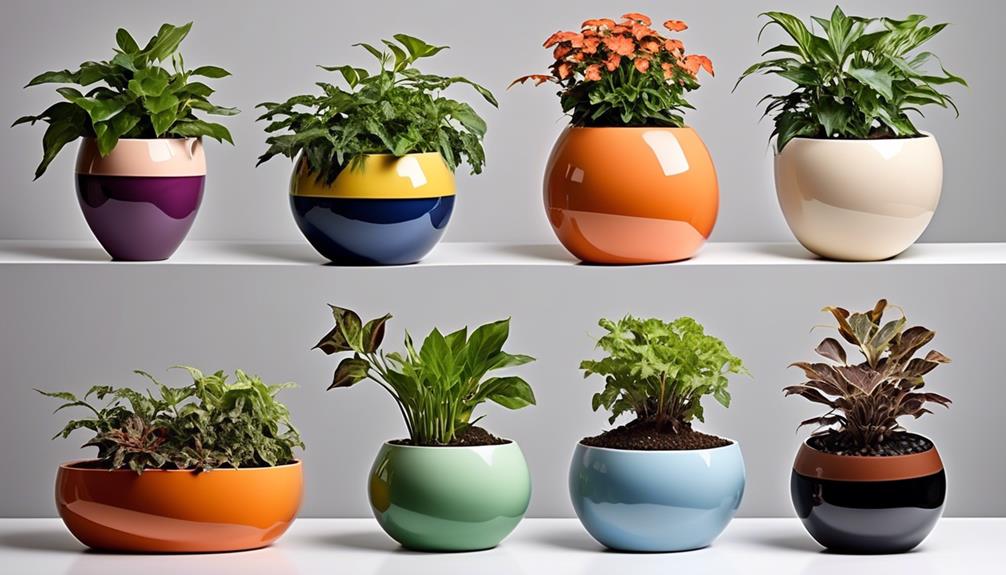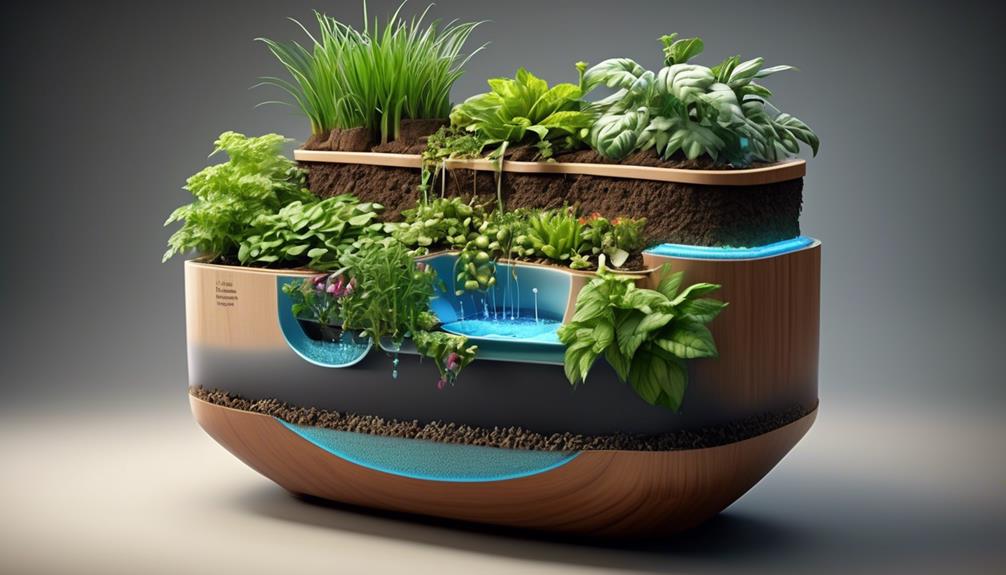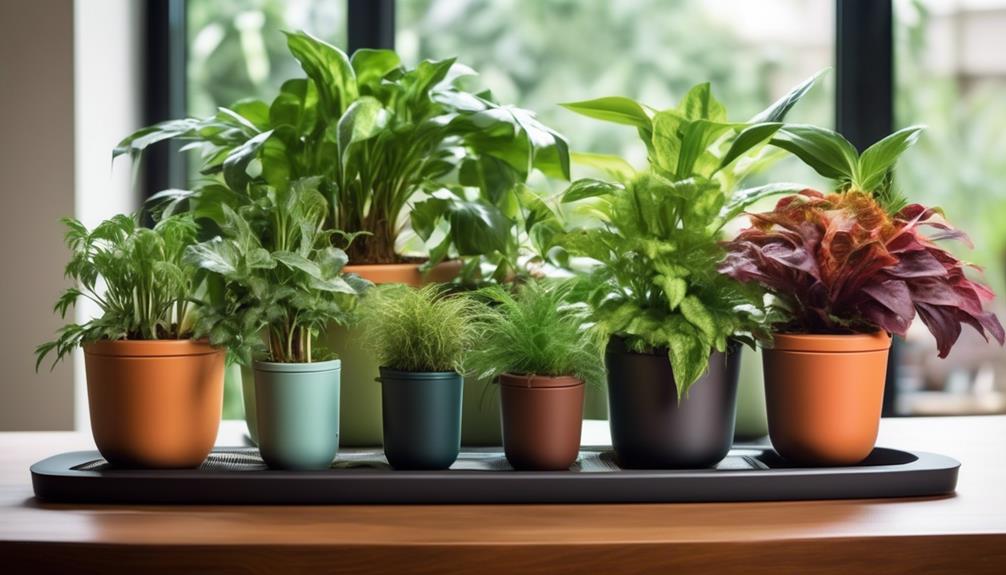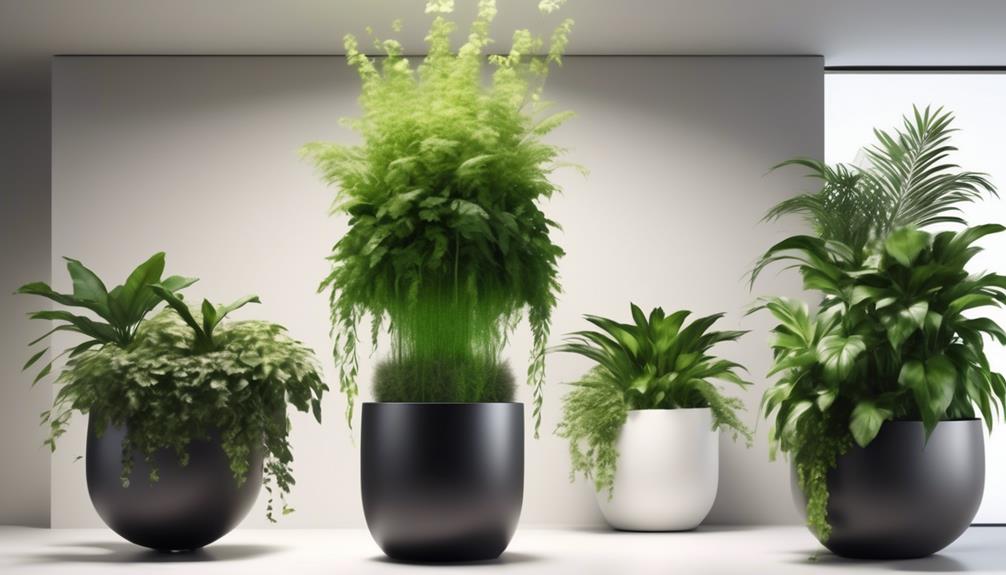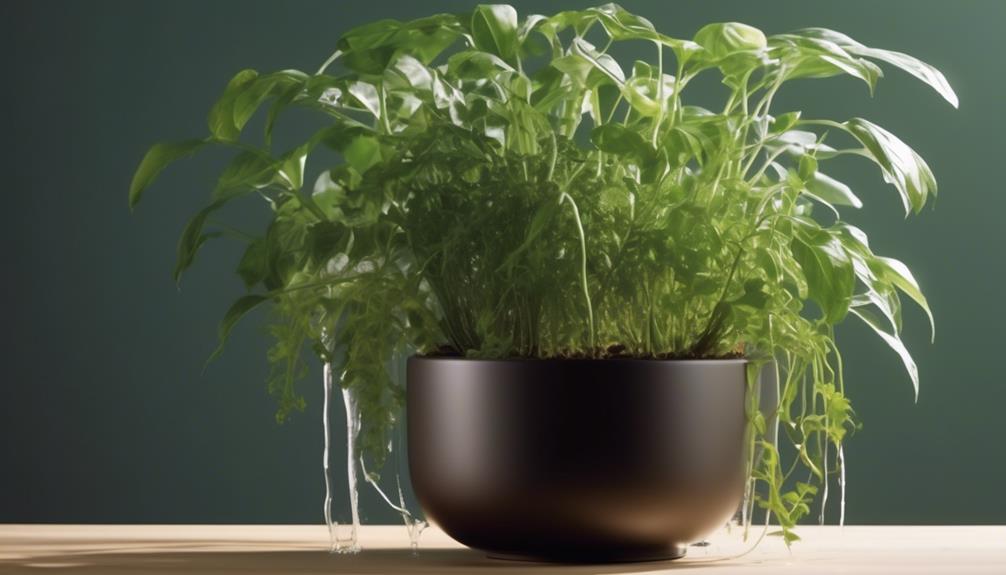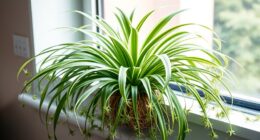The increasing interest in indoor gardening is widely acknowledged. Did you know that the global market for self-watering plant containers is projected to exceed $500 million by 2026?
With such a significant growth trajectory, it's clear that self-watering pots are becoming a staple in the gardening industry.
But what makes these pots so popular, and how can wholesale buyers take advantage of this trend?
Let's explore the benefits, practicality, and potential profitability of incorporating wholesale self-watering pots into your inventory.
Key Takeaways
- Wholesale self-watering pots provide consistent and efficient water delivery to plant roots.
- They help prevent overwatering or underwatering, creating an ideal environment for root development.
- Wholesale self-watering pots reduce watering frequency and contribute to water conservation.
- These pots operate on the principle of capillary action, maintaining soil moisture and minimizing water loss.
Benefits of Self-Watering Pots
Self-watering pots provide a consistent and efficient method for delivering water to plant roots, ensuring optimal hydration levels and promoting healthy growth. The watering efficiency of these pots is due to their unique design, which includes a water reservoir at the bottom. This reservoir allows the plant to draw up water as needed, preventing overwatering or underwatering, both of which can be detrimental to plant health. By maintaining consistent moisture levels in the soil, self-watering pots create an ideal environment for root development and overall plant vitality.
In addition to watering efficiency, self-watering pots offer the convenience of reduced watering frequency. The reservoirs can hold a significant amount of water, extending the time between refills. This not only saves time and effort for the gardener but also contributes to water conservation by minimizing runoff and evaporation. The combination of convenience and water conservation makes self-watering pots an attractive option for individuals seeking an efficient and sustainable approach to plant care.
How Self-Watering Pots Work
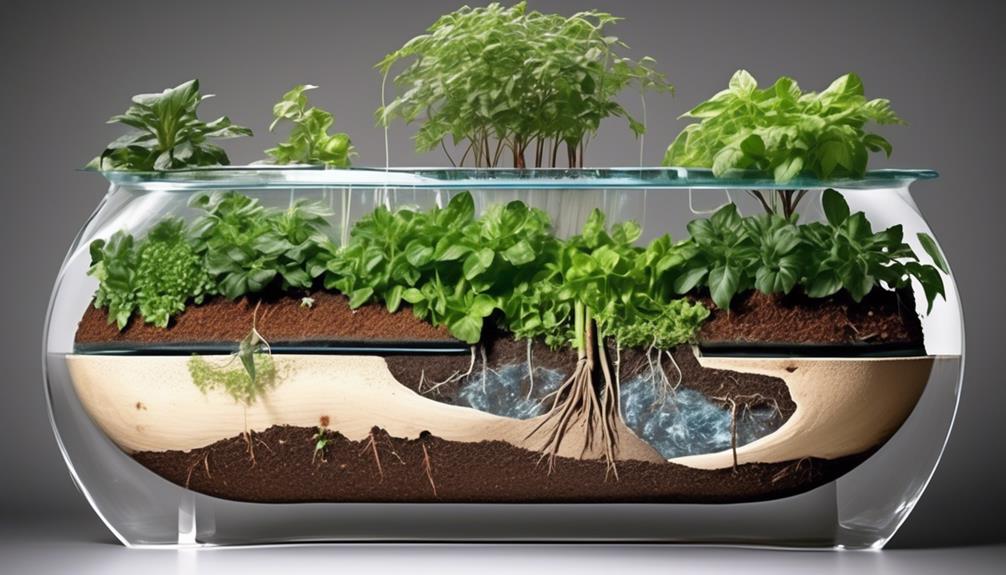
How do the water reservoirs in self-watering pots maintain consistent moisture levels in the soil? The watering mechanism in self-watering pots operates on the principle of capillary action. The pot is designed with a water reservoir at the bottom, separated from the soil by a wicking mechanism, such as a fabric wick or a soil column.
When the soil becomes dry, it creates a moisture gradient that draws water up from the reservoir through the wick and into the soil. This process continues until the soil reaches an optimal moisture level, at which point the capillary action ceases.
As the soil dries out again, the capillary action is reinitiated, ensuring that the soil moisture is maintained within the desired range.
The design of self-watering pots effectively prevents overwatering by allowing the plant to draw up only the amount of water it needs, while also minimizing water loss through evaporation. This mechanism provides a consistent and efficient way to keep the soil moisture at an ideal level for plant growth.
Choosing the Right Size
When selecting the right size self-watering pot, it's crucial to consider the specific type of plant being potted. Different plant species have varying root systems and water requirements, which directly influence the necessary pot size.
Additionally, the water reservoir capacity of the pot should align with the plant's water needs to ensure optimal hydration.
Lastly, the chosen pot size should also accommodate the available space and complement the overall aesthetics of the environment.
Size for Plant Type
Choosing the appropriate size of self-watering pot for your plant type is crucial for ensuring optimal growth and health of your plants. Plant compatibility and size considerations are essential factors to consider when selecting the right pot size.
For smaller plants with shallow root systems, such as herbs or small succulents, a pot with a diameter of 6-8 inches is suitable.
Medium-sized plants like peace lilies or spider plants thrive in pots with a diameter of 8-10 inches.
Larger plants, such as ficus or snake plants, require pots with a diameter of 12 inches or more to accommodate their extensive root systems and provide stability.
It's important to match the pot size to the specific needs of the plant to promote healthy growth and prevent issues such as root binding.
Water Reservoir Capacity
We can determine the appropriate water reservoir capacity for a self-watering pot by considering the plant's water needs and the pot's ability to maintain optimal moisture levels. Watering frequency and plant hydration levels are crucial factors in this determination.
The water reservoir capacity should align with the specific watering needs of the plant. For example, plants that require frequent watering will benefit from a larger water reservoir capacity to ensure consistent moisture levels. Conversely, plants that require less frequent watering may thrive with a smaller water reservoir capacity.
Additionally, the size of the plant and its root system should also be taken into account when selecting the water reservoir capacity.
Space and Aesthetics
Considering the plant's water needs and the pot's ability to maintain optimal moisture levels, a crucial aspect in selecting the right size for a self-watering pot pertains to accommodating the space and aesthetic requirements.
When it comes to space-saving, self-watering pots offer a practical solution for indoor and outdoor environments with limited space. The size of the pot should be chosen based on the available space and the specific plant's requirements, ensuring that it fits seamlessly into the designated area.
Additionally, stylish designs play a significant role in the overall aesthetic appeal of the space. Self-watering pots come in a variety of stylish designs, including sleek and modern options, as well as more traditional and decorative choices. These designs allow for the integration of self-watering pots into various design schemes, enhancing the overall aesthetic of the space while providing efficient water management.
Best Plants for Self-Watering Pots
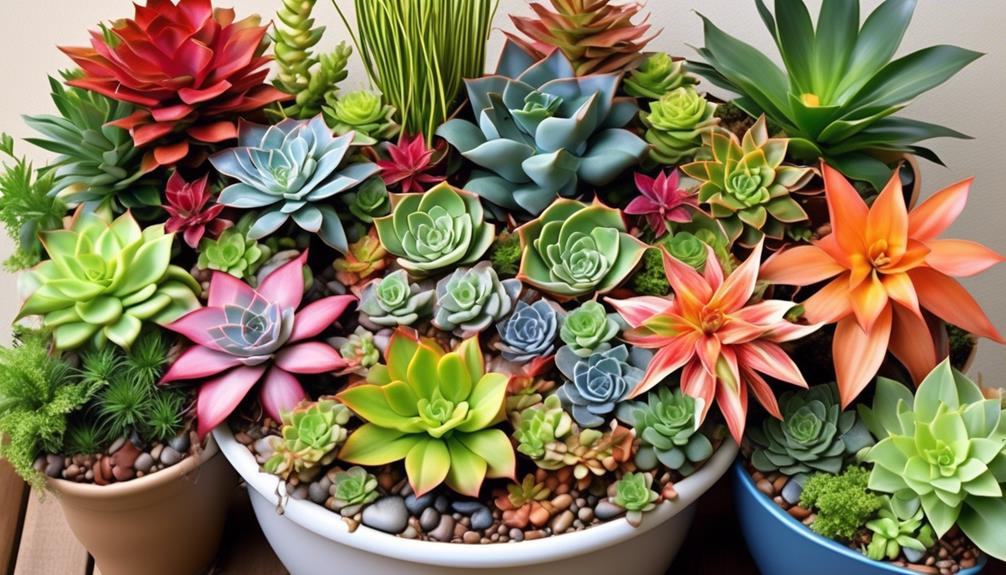
When selecting plants for self-watering pots, it's essential to consider their water requirements, growth habits, and adaptability to container gardening.
Ideal placement for plants in self-watering pots includes those that prefer consistent moisture levels, such as ferns, peace lilies, and certain species of palms. These plants thrive in environments where the soil remains consistently moist but not waterlogged, making them well-suited for self-watering pots.
Proper drainage is crucial for the health of plants in self-watering pots, as excess water can lead to root rot and other issues. Therefore, plants that are suited for self-watering pots should be able to tolerate damp soil without becoming waterlogged.
Additionally, plants with compact root systems, such as African violets and spider plants, are well-suited for self-watering pots due to their adaptability to limited space.
Considering these factors when selecting plants for self-watering pots will contribute to the successful and thriving growth of greenery in these containers.
Maintenance and Cleaning Tips
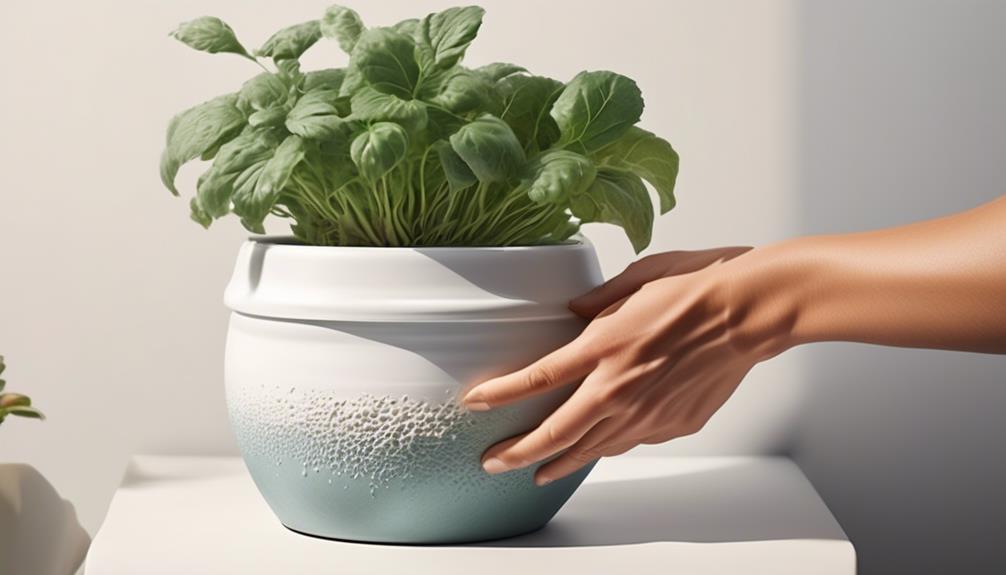
To maintain and clean self-watering pots, it is crucial to ensure proper drainage to prevent waterlogged soil and potential root rot, which can be detrimental to the health of the plants. Regular maintenance and cleaning are essential for the longevity and health of both the plants and the pots. Here are some effective cleaning techniques and longevity benefits to keep your self-watering pots in optimal condition:
| Cleaning Techniques | Frequency | Benefits |
|---|---|---|
| Remove mineral deposits | Every 2-3 months | Prevents clogging of watering system and ensures proper water flow |
| Scrub with mild soap | Every 6 months | Eliminates algae and mold buildup, maintains aesthetic appeal |
| Rinse and air dry | Every 1-2 weeks | Prevents bacterial growth and maintains soil moisture balance |
Implementing these cleaning techniques at the recommended frequencies will enhance the longevity of your self-watering pots, promoting healthy plant growth and reducing the risk of disease. Regular maintenance and cleaning not only benefit the plants but also contribute to the overall aesthetic and functionality of the pots.
Indoor Vs. Outdoor Use
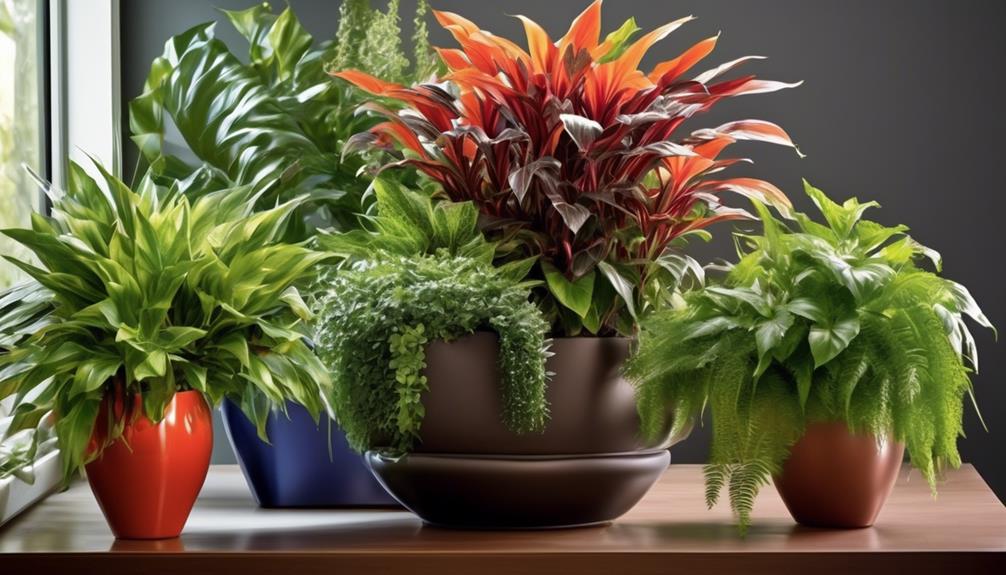
When deciding whether to use self-watering pots indoors or outdoors, it's important to consider the specific environmental factors and plant care requirements for each setting. For indoor plants, self-watering pots offer several advantages, including precise moisture control, reduced watering frequency, and protection against overwatering. However, outdoor gardening presents unique challenges that must be taken into account when using self-watering pots.
- Sunlight Exposure: Outdoor plants may receive more intense sunlight, which can increase evaporation and water consumption. Self-watering pots with larger reservoirs and UV-resistant materials are better suited for outdoor use to prevent water loss and maintain consistent moisture levels.
- Temperature Variations: Outdoor temperatures fluctuate more than indoor environments, affecting water absorption and plant hydration. Insulated self-watering pots with thermal properties can help regulate soil temperature and minimize water evaporation, ensuring optimal growing conditions for outdoor plants.
- Weather Resistance: Outdoor gardening exposes self-watering pots to harsh weather elements such as rain, wind, and frost. Durable, weatherproof materials and a sturdy construction are essential for withstanding outdoor conditions, protecting the pots from damage and maintaining their functionality over time.
Selecting the appropriate self-watering pots for indoor plants and outdoor gardening requires careful consideration of these factors to support healthy plant growth and minimize maintenance efforts.
Wholesale Buying Guide
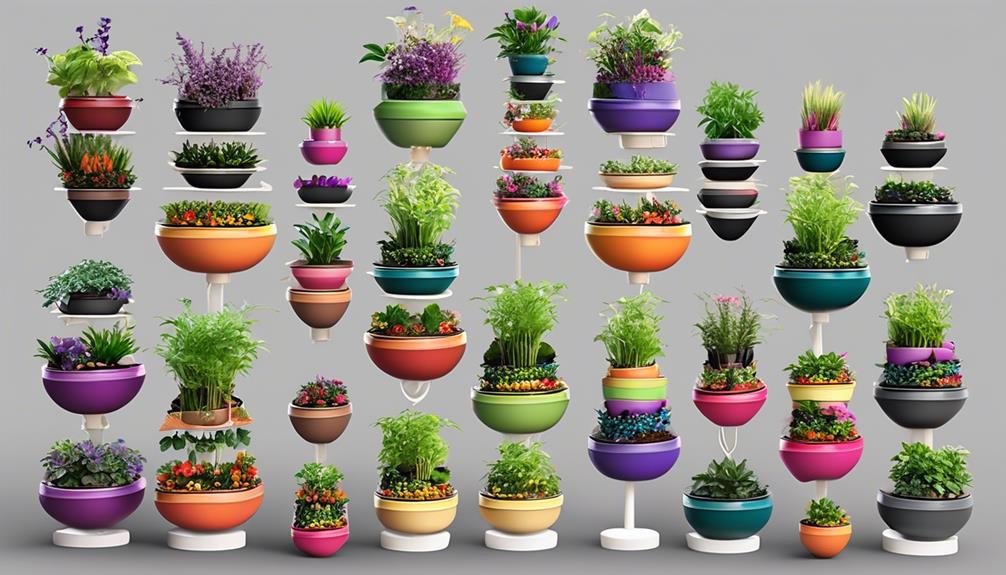
Considering the factors that affect indoor and outdoor plant care, our wholesale buying guide for self-watering pots emphasizes the importance of selecting durable, weather-resistant materials to ensure optimal functionality and longevity in various environmental conditions. When making wholesale purchasing decisions, it's essential to conduct thorough wholesale market research to identify reliable wholesale suppliers offering competitive wholesale pricing. Establishing a distributor network can also aid in managing bulk orders and streamlining wholesale inventory management.
| Factors to Consider | Description |
|---|---|
| Material | Choose high-quality, weather-resistant materials like UV-stabilized polypropylene for durability. |
| Size | Offer a variety of sizes to accommodate different plant types and potting needs. |
| Design | Opt for sleek, modern designs with a self-watering system for efficient water distribution. |
Popular Self-Watering Pot Designs
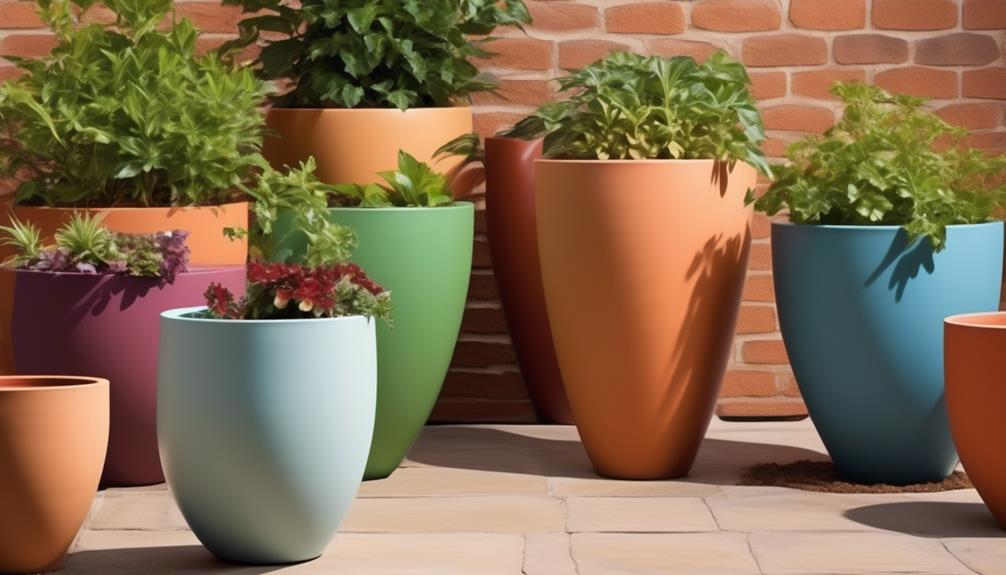
Exploring the market demand for self-watering pots has revealed a trend towards innovative designs that prioritize efficient water distribution and aesthetic appeal. Modern designs are integrating sustainability features to meet the evolving needs of consumers.
Some popular self-watering pot designs include:
- Modular Stacking Systems: These designs feature interconnected pots that allow for vertical stacking, maximizing space utilization. The modular system also provides efficient water distribution throughout the entire stack, ensuring each plant receives adequate moisture.
- Incorporated Water Reservoirs: Many modern self-watering pots are equipped with built-in water reservoirs, which allow for the storage of excess water. These reservoirs not only ensure a steady supply of water to the plants but also reduce water wastage by preventing runoff.
- Aesthetic Integration of Watering Mechanisms: Manufacturers are increasingly incorporating watering mechanisms into the overall aesthetic of the pot, seamlessly blending functionality with visual appeal. This integration enhances the overall design while maintaining the pot's sustainability features.
These modern designs with sustainability features are revolutionizing the self-watering pot market, catering to the needs of environmentally conscious consumers and offering efficient and visually appealing options for indoor and outdoor plant cultivation.
Maximizing Plant Health
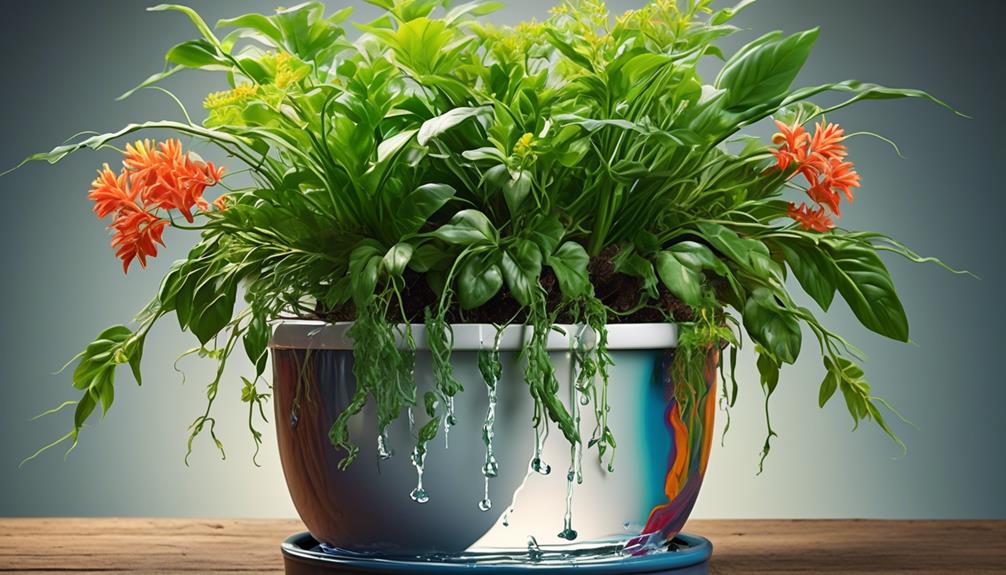
To ensure optimal plant health in self-watering pots, it is crucial to establish a balanced moisture level that meets the specific needs of the plant species being cultivated. Maximizing growth and promoting plant health requires a precise watering schedule tailored to the unique requirements of each plant. We must carefully consider factors such as the plant's water intake, soil composition, and environmental conditions when determining the watering frequency and volume. Below is a table outlining general guidelines for establishing an effective watering schedule based on common plant types:
| Plant Type | Watering Frequency | Watering Volume |
|---|---|---|
| Succulents | 2-3 weeks | Low |
| Herbs | 1-2 weeks | Moderate |
| Leafy Greens | 1 week | High |
Frequently Asked Questions
Are There Any Specific Plants That Should Not Be Grown in Self-Watering Pots?
We should consider the specific plants that are best suited for self-watering pots.
Some plants, such as succulents and cacti, may not thrive in self-watering pots due to their low water requirements.
Additionally, plants that prefer well-drained soil may face potential drawbacks as self-watering pots retain moisture.
It's important to carefully select plants that can adapt to the consistent moisture levels provided by self-watering pots for optimal growth.
How Often Should the Water Reservoir in Self-Watering Pots Be Refilled?
How often we need to refill the water reservoir in self-watering pots depends on various factors like the plant's water needs, environmental conditions, and the pot's size.
For most plants, checking the reservoir every 1-2 weeks is a good starting point. Factors like overwatering risks, soil moisture, and the type of plant will determine the exact frequency.
Certain plants with higher water needs may require more frequent refilling.
Can Self-Watering Pots Be Used in Conjunction With Traditional Watering Methods?
Yes, self-watering pots can be used in conjunction with traditional watering methods. The benefits include consistent moisture levels, reduced watering frequency, and improved plant health.
However, drawbacks may include the need for regular maintenance and monitoring of water levels. While effective, it's important to ensure proper maintenance to avoid issues such as water stagnation.
Are There Any Special Considerations for Using Self-Watering Pots in Extreme Weather Conditions?
When dealing with extreme temperatures, special considerations for using self-watering pots are essential.
The pot material and insulation play critical roles in maintaining optimal conditions for plant growth.
Additionally, the drainage system and watering frequency must be adjusted to prevent waterlogging or dehydration.
It's like navigating a ship through turbulent waters; meticulous care is needed to ensure that the plants thrive despite the challenging conditions.
What Are the Typical Wholesale Pricing Options for Self-Watering Pots?
Typical wholesale pricing options for self-watering pots can vary depending on factors such as materials, size, and features. Wholesale suppliers offer competitive pricing to meet market demand and encourage product innovation.
The benefits of wholesale pricing include cost savings and bulk purchasing options. However, drawbacks may include minimum order quantities and shipping costs.
Understanding market demand and staying updated on product innovation can help in navigating wholesale pricing options for self-watering pots.
Are Wholesale Self Watering Pots Effective for Keeping Plants Hydrated?
Yes, wholesale self watering pots effectiveness for keeping plants hydrated cannot be denied. These pots offer a constant supply of moisture to the plants, keeping them hydrated for longer periods. The effectiveness of self watering pots makes them a popular choice for both indoor and outdoor gardening.
Conclusion
In conclusion, wholesale self-watering pots offer a convenient and efficient solution for maintaining healthy plants. With the right size and design, these pots can help maximize plant health by providing consistent moisture.
Just like a well-oiled machine, self-watering pots keep plants thriving with minimal effort. Whether for indoor or outdoor use, these pots are a game-changer for anyone looking to simplify their plant care routine.
Consider investing in wholesale self-watering pots to elevate your gardening experience.

